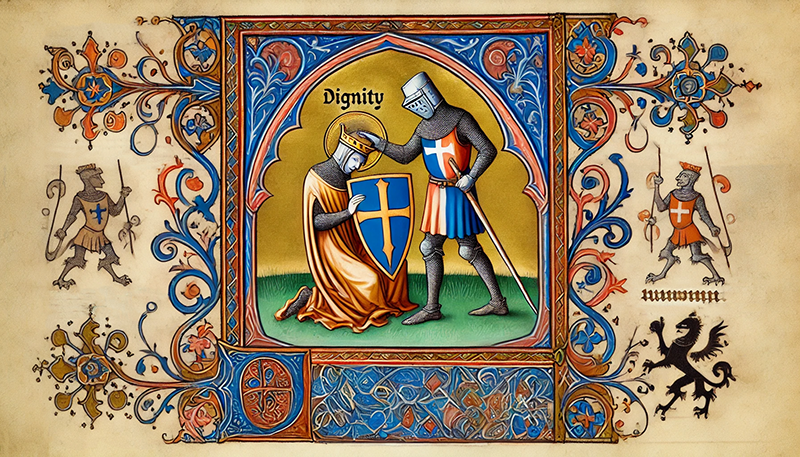The Book of the Order of Chivalry (c. 1275), was written by Ramon Llull (1232–1315), a polymath and Christian mystic from Majorca. Llull thought that knights should be chosen, trained, and ordained like priests. Llull’s book became a handbook of chivalry throughout much of Europe. Being a Christian mystic, of course he writes about Chivalry using Christian vocabulary. But I think his ideas transcend any particular Spiritual Tradition.
Llull wrote over 250 books on a wide range of subjects, including theology, philosophy, logic, science, and even poetry. (And one on Chivalry!) He is best known for his book Ars Magna — a groundbreaking philosophical and logical system that aimed to uncover universal truths using mathematics — now considered the invention of Mathematical Combinatorics. He was also known for his interest in memory and logical systems more generally: his method of linking virtues to physical objects is an example of the ancient memory technique known as the Memory Palace.
An overview of the Order of Chivalry, and a linked table of contents to all my blogs (with music) on various chapters of Llull’s book can be found HERE.

Here Llull equates the knight’s shield with ‘dignity’:
The shield is given to the knight to signify how the knight puts his shield between him and his enemy, likewise the knight is between the prince and the people. And just as the stroke falls upon the shield which saves the knight, so also the knight places his body in front of his lord when he is in peril, hurt, or taken.
Llull’s comparison of the knight’s shield to dignity offers insight into the role of the knight as both a protector and a figure of noble responsibility. The shield, a defensive tool that absorbs blows, becomes a symbol of the knight’s moral duty to place himself between danger and those he serves, reflecting the dignity inherent in self-sacrifice and service.
“The shield is given to the knight to signify how the knight puts his shield between him and his enemy.”
The shield serves as a barrier between the knight and harm, symbolizing the knight’s role as a protector. In this way, the knight’s dignity is not just personal but relational—he exists to defend those who cannot defend themselves, placing himself in harm’s way for the greater good. This protective stance is where dignity resides, for it reflects the knight’s noble commitment to others. In spiritual traditions, dignity often stems from the recognition of one’s responsibility toward others. In Judaism, for example, the concept of tzedakah (charity) emphasizes the dignity found in giving and protecting the vulnerable.
“Likewise the knight is between the prince and the people.”
Llull points out that the knight stands in a pivotal position, between the prince (or lord) and the people, acting as a shield for both. The knight’s dignity is found in this intermediary role, where he is entrusted with the responsibility of protecting not only his lord but the broader community. Dignity, therefore, is tied to service and the ability to act as a guardian for the greater good. Many traditions reflect this idea of dignity as tied to service. In Confucianism, dignity is found in fulfilling one’s role in society, with those in positions of authority expected to act as protectors of the people, embodying virtues like justice and integrity.
“Just as the stroke falls upon the shield which saves the knight.”
The image of the shield absorbing the blows intended for the knight reflects how dignity requires a willingness to endure hardship for the sake of others. The knight’s dignity is expressed not in avoiding danger but in facing it head-on, knowing that by doing so, he protects those under his care. This act of bearing the brunt of danger for others is central to the knight’s role and reflects the highest expression of dignity: the willingness to sacrifice personal safety for a greater cause. This echoes the Christian concept of kenosis, or self-emptying, where dignity is found in giving oneself for the sake of others.
“The knight places his body in front of his lord when he is in peril, hurt, or taken.”
Llull emphasizes that the knight’s dignity is not only in his ability to protect but in his readiness to sacrifice his own life for his lord’s safety. This ultimate act of devotion and self-sacrifice highlights that true dignity is rooted in loyalty and courage. The knight’s dignity is not just a reflection of his external status but an inner strength that compels him to act honorably, even at great personal cost. In many spiritual traditions, dignity is tied to sacrifice and selflessness. In Islam, for instance, the concept of izzah (honor and dignity) is closely linked to standing firm in the face of adversity and protecting the vulnerable, even at personal risk.
In conclusion, Llull’s metaphor of the knight’s shield as dignity reveals that true dignity lies in the knight’s protective role and his willingness to sacrifice for the safety of others. The knight’s shield symbolizes his commitment to defend his lord and his people, placing himself in harm’s way with honor and courage. Across spiritual traditions, dignity is seen as something earned through service, sacrifice, and a steadfast commitment to doing what is right, even when it is difficult. Llull’s vision reminds us that dignity is not about personal glory or status but about the moral strength to protect and serve others with honor and integrity.



Leave a Reply